#horseshoe island
Explore tagged Tumblr posts
Text

12 notes
·
View notes
Text

A fur seal is seen on Horseshoe Island as Turkish scientists conduct fieldwork in Antarctica
Photograph: Anadolu Agency/Getty Images
#anadolu agency#getty images#photographer#fur seal#seal#animal#mammal#wildlife#horseshoe island#antarctica#nature
29 notes
·
View notes
Text
starting today I am going to be annoying on purpose about my game and I'm gonna talk about my game and I'm gonna make you look at my game and all my silly little characters
10 notes
·
View notes
Text
🎥: pamwmsn.tumblr.com
Horseshoe crab at Hunting Island beach.
12 notes
·
View notes
Text

Horseshoe crab with a mane of algae
10 notes
·
View notes
Text

23 November 2024 | Peninsula State Park, Door County, Wisconsin
Horseshoe Island
5 notes
·
View notes
Video
Towards Vancouver Island in the early morning [IMG_0983] by Kesara Rathnayake Via Flickr: Photo taken from Horseshoe Bay, Vancouver
#Vancouver Island#Vancouver#sky#horizon#sea#mountains#hills#island#travel#travelling#transport#transportation#ferry#Horseshoe Bay#British Columbia#BC#Canada#water#moring#sunrise#trees#foto#photo#photography#seascape#landscape#canon#16mm#wide angle#flickr
9 notes
·
View notes
Text
Horseshoe Crabs in Wellfleet 05/04/24

View On WordPress
5 notes
·
View notes
Text






























Governor of New York David B. Hill signed legislation creating the Niagara Reservation, New York’s first state park on April 30, 1885, ensuring that Niagara Falls will not be devoted solely to industrial and commercial use.
#Governor of New York#legislation#Niagara Reservation#Niagara Falls#30 April 1885#anniversary#US history#Ontario#Canada#travel#summer 2018#Horseshoe Falls#American Falls#Bridal Veil Falls#water#landmark#tourist attraction#landscape#cityscape#original photography#flower#flora#nature#Goat Island Bridge#Niagara River#waterfall#vacation#2009#2012#USA
3 notes
·
View notes
Text
#OTD in Irish History | 13 July:
1344 – Ralph de Ufford arrives in Ireland as justiciar with a small English army and investigates the situation in Cork. 1809 – Founding of the Dublin Harp Society. 1815 – Birth of physician, surgeon, newspaper proprietor, journalist and politician, John Gray, in Co Mayo. Gray was active both in municipal and national government for much of his life, and had nationalist ideals – which he…

View On WordPress
#irelandinspires#irishhistory#OTD#13 July#Co. Cork#History#History of Ireland#Horseshoe Bay#Ireland#Irish Civil War#Irish History#Irish War of Independence#Martin Hurson#Photo credit: Dennis Horgan#Sherkin Island#Today in Irish History
8 notes
·
View notes
Text

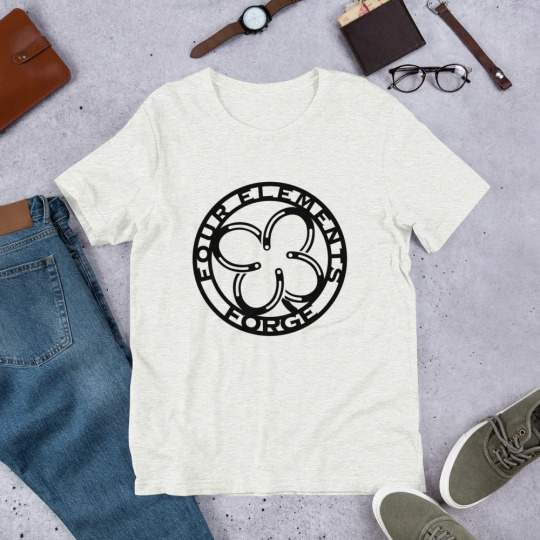

I rearranged MinaMart—I am a cheapo so I can only have 5 products listed at a time, but I like these 5 products! They are all reasonably-priced shirts now. :) (I didn't like the sticker quality.) They are all pretty much tshirts I want to own. That's why they're there. I will order them when I find a job.
(the shop is here, minamart.bigcartel.com)
#my art#koholint island#totk#minish cap#(i think 'four elements forge' is an LU thing but I came up with the design and it looks like a kinstone made of horseshoes)
6 notes
·
View notes
Text

The ancient mariner
A tri-spine horseshoe crab moves slowly over the mud. Its golden protective carapace hides 12 appendages. Above the horseshoe crab, a trio of juvenile golden trevallies are poised to dart down for edible morsels ploughed up by its passage.Portfolio Story: Laurent Ballesta went looking for the crabs in the protected waters of Pangatalan Island in the Philippines. Marine biologist and photographer Laurent Ballesta has dedicated his life to exploring the oceans and revealing their wonder through art. He has led a series of expeditions, all involving scientific mysteries and diving challenges, resulting in unprecedented images. The tri-spine horseshoe crab has survived for more than 100m years but faces habitat destruction and overfishing for food and for its blood, used in the development of vaccines. But, in the protected waters off Pangatalan Island, there is hope for its survival.
by Laurent Ballesta, France.
2023 Wildlife Photographer of the Year
#tri-spine horseshoe crab#crab#golden trevallies#pangatalan island#philippines#laurent ballesta#photographer#france#wildlife photographer of the year#nature#marine life
79 notes
·
View notes
Text
I am genuinely devastated to learn this. I love horseshoe crabs, and I love Chincoteague and Assateague. I am heartbroken.
I hate capitalism.
Okay, I know people as a general rule tend to not care about invertebrates as much as cute, fuzzy mammals, but this is a must-read if you care about animal welfare. The short version is that horseshoe crab blood has been used for decades in medicine as a way to test whether something is truly sterile; the blood clots in the presence of bacteria. Since then millions of horseshoe crabs have been captured and drained of blood, even though a synthetic alternative was developed a few years ago.
They go through a pretty brutal experience in the process. They're caught by fishermen who often throw them by their tails into a pile in the open air, and they're then trucked to a bleeding facility where they're strapped down and their blood is removed with needles jabbed directly into their hearts. Over half their blood may be taken, after which they're supposed to be returned to the ocean. However, it's likely many of them never make it back, instead turned into fish bait and sold by the same fishermen who caught them in the first place.
Apart from the fact that this is a horrific thing to put any animal through, the attrition due to fatalities has put a serious dent in horseshoe crab numbers. This is compounded by massive habitat loss, pollution, and the capture of horseshoe crabs as food, particularly as the females of one species are considered a delicacy. And other animals that rely on horseshoe crabs are suffering, too. The American rufa subspecies of the red knot, a medium-sized shorebird, is critically endangered as the horseshoe crab eggs it must have in order to successfully complete migration have become increasingly scarce, and it is likely the bird will become extinct if trends continue.
While there are guidelines for medical horseshoe crab harvest, they're considered optional. The few laws that exist are poorly enforced. Short of a complete ban on horseshoe crab blood in favor of the synthetic alternative, these animals are in very real danger of going extinct after a history spanning over 400 million years on this planet.
Thankfully, this article is not the first to bring forth the issues surrounding horseshoe crab harvest. Here are a few resources for further information and action (US based, though horseshoe crabs are threatened throughout their entire range):
Horseshoe Crab Conservation Network - https://horseshoecrab.org/conservation/
Wetlands Institute - https://wetlandsinstitute.org/conservation/horseshoe-crab-conservation/
Horseshoe Crab Recovery Coalition - https://hscrabrecovery.org/
#I hate capitalism#catipalism over capitalism#it is guillotine o’clock#horseshoe crabs#Chincoteague#Assateague#assateague island#Chincoteague island#animal cruelty#animal welfare#cw animal cruelty#animal suffering#invertebrates#wildlife#animals#environment#conservation#TW: animal cruelty#TW: animal death#to do#call your congresspeople
8K notes
·
View notes
Text
Guess who recently started animal crossing new horizons?
#sorry for the spam#it will keep happening lol#want my island to actually look cool#gonna make a horseshoe crab rave room#lots of inspiration ✨✨✨#never paying for Nintendo online so gonna have to make my own stuff#kind of want to do something based off cyber city?
0 notes
Text

A tri-spine horseshoe crab kicks up sediment along the muddy bottom of the Pangatalan Island Marine Protected Area in the Philippines. After a decade of restoration work to the islet’s bay, its green waters are rich with plankton and ready to welcome back bigger animals.
Dazzling Photos Show Horseshoe Crabs Thriving in Protected Area
In the Philippines, the tri-spine horseshoe crab has made a home and other species are returning too.
— By Amy McKeever | Photographs By Laurent Ballesta | Published:July 12, 2022 | Saturday 05 August, 2023
Horseshoe crabs are built to last. With spiky tails, shells shaped like combat helmets, and sharp pincers at the end of eight of their 10 legs, these ancient invertebrates have been scuttling along the ocean floor relatively unchanged for some 450 million years.
They managed to survive the asteroid that killed the dinosaurs. Surviving humans may prove more difficult. Like many marine animals, horseshoe crabs are overfished for food and bait, and coastal development has destroyed spawning sites. But they also are collected en masse for their blue blood, which contains a rare clotting agent critical for the development of safe vaccines. The blood may be lifesaving for humans, but its harvest often kills the animals—particularly in much of Asia, where they are drained of all their blood rather than just a portion of it.

A horseshoe crab hides an ecosystem within its shell. The hairlike objects along its body are hydroids—tiny, fuzzy invertebrates related to jellyfish—and there are at least eight shrimps clinging to the crab’s pincers. Horseshoe crabs are relatively unstudied; little is known about how they interact with other species.

A tank-like horseshoe crab pushes itself across Pangatalan’s reef, which has benefited from the planting of mangroves and creation of artificial reefs. Members of the class Merostomata—which means “legs attached to the mouth”—horseshoe crabs are more closely related to spiders and scorpions than to crustaceans.
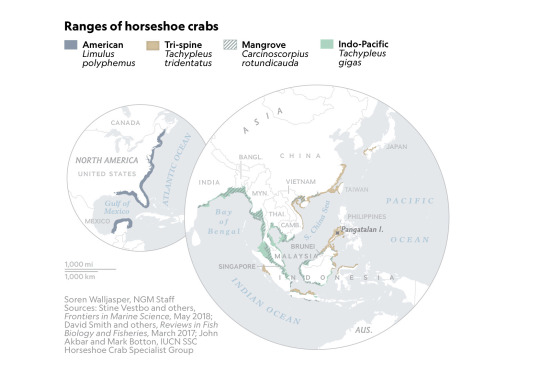
Tri-spine horseshoe crabs have lost more than half their population in the past 60 years. But on the Philippine islet of Pangatalan, the species is an unexpected symbol of resilience. For years the island’s 11 acres were degraded: trees cut down for timber, mangroves burned for charcoal, and coral reefs overfished with dynamite and cyanide. By 2011 these horseshoe crabs, about 15 inches long, were among the biggest creatures left.
Now a marine protected area, Pangatalan is starting to thrive again. Efforts to restore its reefs and plant thousands of trees have led many animals to return, including rare giant groupers that grow to some eight feet long.
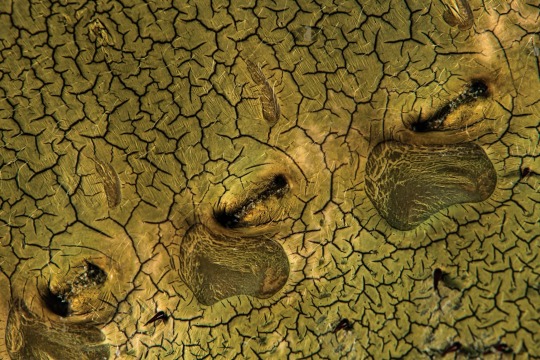
This isn’t an alien landscape—it’s an extreme close-up of the topside of a horseshoe crab’s abdomen. The gills are on the underside, and the dashes and indentations mark where they attach to the exoskeleton. The dark points beneath are minute spines that may function as whiskers do on a cat.
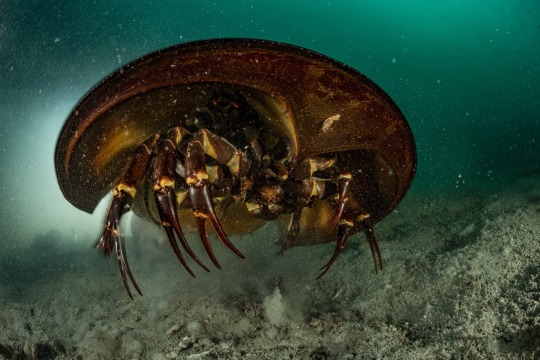
“Be beautiful or be shocking”—these are typical tactics used to get people to care about nature, says photographer Laurent Ballesta. “I think there’s a third way,” he says. “Try to show the mysteries. When you are in front of something you don’t understand, you forget beauty.”
Horseshoe crabs may not be as charismatic as elephants or pandas, but perhaps they’ll inspire people to care more about wildlife. Appreciation for horseshoe crabs has grown thanks to their role in COVID-19 vaccine development. Conservationists hope that regard will translate to stronger habitat protections and wider adoption of a synthetic alternative to crab blood—saving horseshoe crabs just as they’ve helped save us.
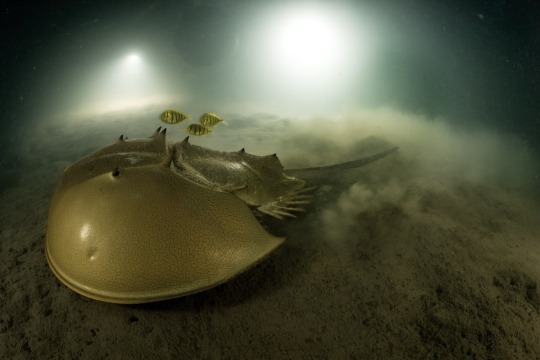
Golden trevallies swim above a horseshoe crab, hoping to catch leftovers as it digs in the mud for clams and other prey. As bigger fish slowly return to the reef, horseshoe crabs may no longer rule the ecosystem. But they remain symbols of its resilience.
— Amy McKeever is a Senior Staff Writer. Laurent Ballesta, named Wildlife Photographer of the Year in 2021, is also a Marine Biologist.
#Photographs#Horseshoe Crabs 🦀#Protected Area#Pangatalan Island Marine Protected Area#Philippines 🇵🇭#Tri-spine Horseshoe Crab#Amy McKeever#Laurent Ballesta#Ancient Invertebrates#Spiky Tails#Shells Shaped | Combat Helmets#450 Million Years Old Species#Asteroid ☄️#Dinosaurs 🦕#Lifesaving For Humans#Ecosystem#Hydroids#Jellyfish#Shrimps#Pincers#Pangatalan’s Reef 🪸#Merostomata: Legs Attached to the Mouth#American: Limulus Polyphemus#Tri-spine: Tachypleus Tridentatus#Mangrove: Carcinoscorpius Rotundicauda#Indo-Pacific: Tachypleus Gigas#COVID-19#Conservationists#Golden Trevallies#The National Geographic
0 notes
Text
MAGNETIC ISLAND

View On WordPress
#breakwater#Captain Cook#Duck Pond#Hinchinbrook Channel#Horseshoe Bay#Magnetic Island#Marina#Orpheus Island#Palm Island#Townsville
0 notes
![Towards Vancouver Island in the early morning [IMG_0983]](https://live.staticflickr.com/65535/53946366834_c989823f89_b.jpg)